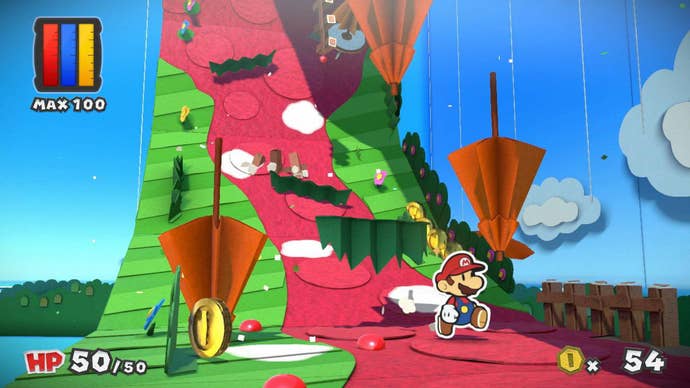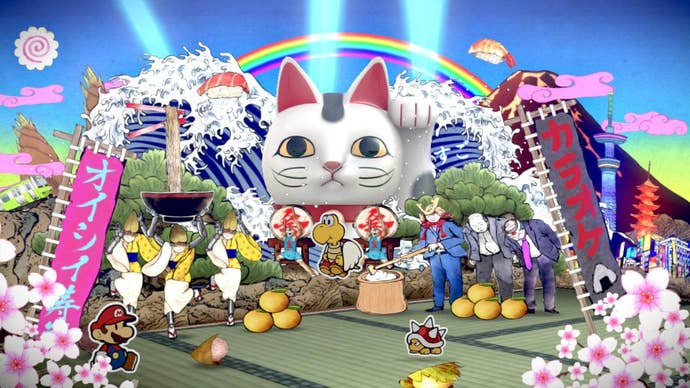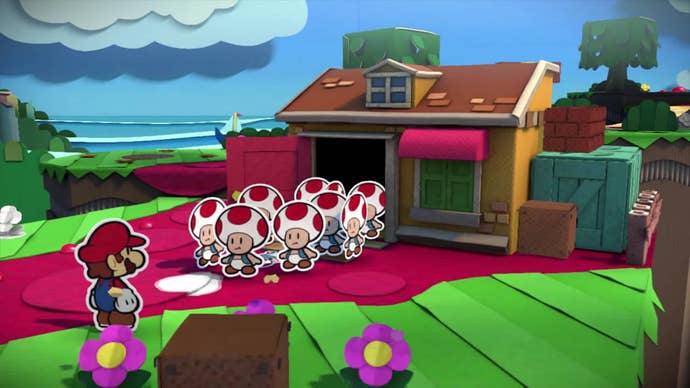A Conversation With Paper Mario: Color Splash Producer Risa Tabata
The game's green producer talks about the RPG that has some Nintendo fans seeing red.
This article first appeared on USgamer, a partner publication of VG247. Some content, such as this article, has been migrated to VG247 for posterity after USgamer's closure - but it has not been edited or further vetted by the VG247 team.
These days, it seems like Nintendo can't make even the most innocuous business decision without courting ferocious controversy and anger within the fan community. And nothing makes Nintendo fans more enraged these days than when the company makes video games (well, outside of monetizing their intellectual properties on YouTube and protecting their intellectual properties by killing fan games).
The next game due out in Nintendo's parade of bitter provocation will be Paper Mario: Color Splash, the fifth game in the long-running Paper Mario RPG series (sixth if you count the recent Mario & Luigi crossover). The second result for "Paper Mario Color Splash" on Google Images is a change.org petition to straight up cancel the game, for crying out loud. The most recent full entry in the Paper Mario lineup, 2012's Sticker Star, was somewhat divisive to be sure, but was it really a "mistake" that Nintendo needed to "learn from," as the cancellation petition charges?
Perhaps so, as the biggest sticking points with Color Splash appear to be that it will uphold Sticker Star's less popular conventions, such as being based entirely within the familiar environs of the Mushroom Kingdom and using a finite resource as the basis for its combat system. I spoke with co-producer Risa Tabata about these and other choices within the game back at E3 (an excerpt of this interview has previously been published) to get a better sense of the creative thinking behind the series' new trajectory under its new producer.
USgamer: There have been several Paper Mario games now, so, can you talk about the specific theme for this one? What sets it apart from previous games?
Risa Tabata: One of the main themes for this game is color, as in its title.
In terms of how we came to that theme of color... obviously, you know we've made this game in conjunction with a company called Intelligent Systems. There was a manager at Intelligent Systems by the name of Ikunami. He mentioned at the time that his kids had gotten very into painting, painting different colors, so he thought maybe that could be something to base the game around. So, that was basically the starting point.
Since we also knew we were going to be making a game for HD hardware, the Wii U, we want to use the special functions of its hardware. So, the Wii U, the gamepad, the touchpad... we thought it would be fun to be able to use that touchpad to sort through your cards and fling them up at the TV, so that's what we settled on, using cards as the battle system.

USG: Yeah, the flip mechanic is something we saw in the original Wii U announcement trailer, but haven't really seen in game. It's nice that it's finally come around. So, up through Super Paper Mario, the Paper Mario games worked towards abstraction. That game was full of digital elements and a strange surreal imagery. But it seems like the past few Paper Mario games have been much more grounded in an arts and crafts style, with stickers and finger paints.
Tabata: Am I right in thinking you're asking about the graphical style?
USG: Not just the graphics, but you have the elements like the box fans — real-world objects are entering into the series.
Tabata: Well, I think one factor here is the fact that now it's on this Wii U hardware and we're able to present it in HD. Obviously, it's going to be visually richer. Since it's "Paper" Mario, we thought, let's make it really look like it's made out of paper. We focused a lot on the quality of the paper, making the paper look real... but, obviously, because it's a Mario game, we want to make it... not exactly fantasy, but to give it a kind of cuteness that's appropriate for a Mario title. Having those real-word objects come in works like an accent, or punctuation. So, when you have this world that's made entirely of paper, and you have these real objects, a completely different quality entering in, that jarring sensation has a lot of impact, and it's also very interesting and funny.
USG: The original Paper Mario felt like a reaction to the technical limitations of the time, because you saw a lot of N64 games with 3D worlds, but then sprite based characters, so it seems like Intelligent Systems took that and said, Let's really play that up. Obviously, you don't have that problem now on Wii U. So, does that pose its own challenge for inspiration, for ideas? Sometimes the best ideas come from limitations, and now you don't have those limitations.
Tabata: As you say, as the hardware's gotten more powerful we have a lot less limitations. And so, we kind of look at it in new ways — now that we have this extra power, what are the extra things that we can do with it? And so, we've focused a lot on the environments, and terrain is very much made in 3D space. So, as you proceed deeper into the level, you'll have the camera follow you around, and you'll see how fully realized the environments are. I don't know if that's a good answer to your question....
USG: I also meant in terms of just coming up with basic ideas. We don't have those limitations, so, where does, thematically, the Paper Mario series go from here? You mentioned the child who is obsessed with finger paints, but in terms of the overall design of the story, I'm curious how the technology and the fact that you're creating iterative sequels factors in as well.
Tabata: I mean, I think the main thing I want to focus on is, when we have new hardware, focus on what are the specific abilities that that new hardware has.

USG: So, in terms of Color Splash, what does that mean, with the Wii U, specifically? How did you arrive at these elements for the touch screen? Sticker Star was on 3DS, which also had a touch screen. So, what differentiates this from the previous use of that technology?
Tabata: So, I think one thing is that the screen is quite a bit bigger, so you can have more objects there on the screen. It would be really hard to look at all those cards on the much smaller 3DS screen. And so, you have all these things that are right there in your hands, but we were able to make it look a lot more pleasant, be a lot more pleasant user experience.
Also, this isn't necessarily a difference between the 3DS and the Wii U, but there are different ways that we're using that technology as well, not just the cards. There's actually this ability called Cut Out in the game. The concept is you have this 3D world on the screen that you collapse into 2D and bring it down to the gamepad screen. So, you can see a dotted line in the environment as you draw onto that screen. And if you trace along that screen, that line, that actual area of the environment will just peel up and pop out. And so, in that space that you cut out, you might put a card in there, or you might actually put Mario in there, and he's able to run along and get somewhere he might not normally be able to.
And finally, this is the Wii, so you can play it on your TV, so you can play it on a large screen. You're able to use the gamepad to get off TV, play as well, and get that kind of feel from right there in your hands.
USG: So, when you do off-screen play... the touchpad interface is important to combat, so how does that work, exactly?
Tabata: So, if you're in battle on Gamepad-only mode, you'll get this kind of picture-in-picture view of what's actually happening. While you're exploring, you'll have that on there, and when you enter into battle, you'll have the battle card screen flop in and get this picture-in-picture.
USG: The Wii U does have capabilities the 3DS didn't, including much more robust online and Miiverse support, and the ability to get other people to play with Wii remotes or motion controls. Do any of those factor into the game?
Tabata: No, this game doesn't support the multiplayer and additional Miiverse. We really wanted to create a good single-player experience, and have people really come into this world and enjoy the puzzle-solving aspects of this game.
USG: It seems like the Mario RPG concept has taken to an alternating schedule, with Paper Mario and then with Mario & Luigi. What differentiates those two series? How do you keep those two general concepts, both of which involve Mario and an RPG adventure, separate and distinct?
Tabata: So, as you know, the first Paper Mario was very much a role-playing game, and Mario and Luigi is of course also a role-playing game. Yeah... obviously, we have these two RPG series, but they both allow us to offer new and varied experiences to players.
The old Paper Mario games, they were obviously RPGs and had a lot of good elements, but they weren't just about the RPG elements. They were full of solving puzzles, solving mysteries, the color factor, the visual style. For the Paper Mario series, we're focusing more on those elements — the puzzle-solving.
On the other hand, the Mario & Luigi RPG series is created more in a 2D space. And obviously, because we have this fully realized 3D world in the Paper Mario games, we're able to have much more dynamic events, like you saw in the trailer, with the game being rolled up and the camera panning around.
There's a developer by the name of Taro Kudo who worked on the previous game as well, and he's been basically the overall director for the story and the dialogue in this game. He's very very good at coming up with gags and jokes, but he's also very good at crafting a good story. And I think if you play the game to the end, you may actually cry at the end. We did some test plays and there really were people who cried at the end.

USG: Do you work closely with the localization teams? Because, as you say, there are a lot of gags and a lot of emotional elements to the games, and that can be difficult to translate from one culture, one language to another.
Tabata: As you say, it's very difficult to translate jokes, so rather than having the localization team just translate Japanese jokes, we worked very closely to make sure that the English writers actually came up with jokes that work in English, jokes that would be funny in this market. And I think the creativity of the localization team is on display. You were laughing [at the dialogue], so I think it worked out.
USG: Let's talk about the use of, the importance of limited resources in combat. That's something that the series introduced with Sticker Star, and it was kind of a hotly debated element. Some people liked it and some people didn't. But, you've gone back to that with this one, so, clearly you think it's something that works. Games need limited resources to keep them interesting, but I mean for just basic actions. You know, using a hammer or jumping, those are things Mario can do. So, why does he need cards or stickers to help him do that in this game?
Tabata: So, as you kind of touched on, I think the main thing, the basis of what we want to do is provide a unique experience. So, I think when you have a limited number of cards, it kind of increases the depths and extent you have to think. Like, if I have a hammer card — should I use it now, or should I wait until later? But this game has a lot of different cards. If you wanted to look at them in one straight line, it would be giant. And I think, it's also important that, because they're cards, and they just have these simple images on them, you look at them once and know exactly what it is, and that's very important, too.
USG: Another big change that the series implemented with Sticker Star was, instead of having a lot of unique original characters in the game, it focused more on Mario and Toad and Bowser, whereas the previous games had a lot of weird NPCs that accompanied Mario. And I see that's continued, or seems to be continued, with this.
Tabata: So, I wasn't really involved with the previous title, so I'll just talk about this one. But I think one thing is that because this is taking place within the greater Mario world, we wanted to focus as much as possible on the familiar Mario characters. All Toads, right? It's just a bunch of Toads. So, we had to think, if it's all Toads, how do we make them distinct and give them personality? So, one thing we thought, so, the basic Toad is red, and if they have something different about them, we'll change the color. And of course, a lot of the personality comes out in text. And so, you can also use the fact that they all look alike as the basis for jokes. So, one thing we're going to focus on, because we have all those limits, obviously, we're using all these familiar characters, is: How do we create variety, and how do we create interest?

USG: You've said that this is your first Paper Mario game, right?
Tabata: Yes.
USG: Coming in as someone new, working on a series that's been around for 15 years — what do you personally hope to bring to Paper Mario?
Tabata: I think because I didn't have experience in the previous titles, I was able to provide good insight on how to make Color Splash enjoyable for someone who would be new to the series. So, I'm always thinking about what's new, what can be done that hasn't been done before. I hope that maybe I've been able to come up with some gags or ideas that hadn't been thought of before. Yeah, I think if you're always doing the same thing, you don't really get inspiration to do something new, so that's what I hope with this.
USG: I'll wrap it up after this. Just as a final question, what would you like for players to take out of this game that maybe they haven't experienced with other Mario games?
Tabata: There's such a rich variety of different events in the game. So, if you just play through the game, I think you'll get lots of different fresh things that you haven't gotten before. And I hope people get a sense of satisfaction when they solve a puzzle.
I think people will progress in the story, they'll see, it's a lot deeper, and I hope people feel really close to Huey [Mario's companion character in this game] and think, "Man, Huey's a real good guy." I hope they get a lot out of the story.
And, also, it just feels really good to paint things. I hope people sling paint everywhere.








